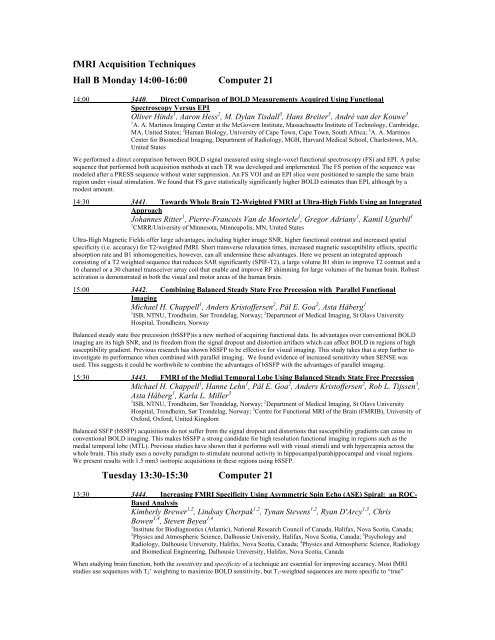ELECTRONIC POSTER - ismrm
ELECTRONIC POSTER - ismrm
ELECTRONIC POSTER - ismrm
Create successful ePaper yourself
Turn your PDF publications into a flip-book with our unique Google optimized e-Paper software.
fMRI Acquisition Techniques<br />
Hall B Monday 14:00-16:00 Computer 21<br />
14:00 3440. Direct Comparison of BOLD Measurements Acquired Using Functional<br />
Spectroscopy Versus EPI<br />
Oliver Hinds 1 , Aaron Hess 2 , M. Dylan Tisdall 3 , Hans Breiter 3 , André van der Kouwe 3<br />
1 A. A. Martinos Imaging Center at the McGovern Institute, Massachusetts Institute of Technology, Cambridge,<br />
MA, United States; 2 Human Biology, University of Cape Town, Cape Town, South Africa; 3 A. A. Martinos<br />
Center for Biomedical Imaging, Department of Radiology, MGH, Harvard Medical School, Charlestown, MA,<br />
United States<br />
We performed a direct comparison between BOLD signal measured using single-voxel functional spectroscopy (FS) and EPI. A pulse<br />
sequence that performed both acquisition methods at each TR was developed and implemented. The FS portion of the sequence was<br />
modeled after a PRESS sequence without water suppression. An FS VOI and an EPI slice were positioned to sample the same brain<br />
region under visual stimulation. We found that FS gave statistically significantly higher BOLD estimates than EPI, although by a<br />
modest amount.<br />
14:30 3441. Towards Whole Brain T2-Weighted FMRI at Ultra-High Fields Using an Integrated<br />
Approach<br />
Johannes Ritter 1 , Pierre-Francois Van de Moortele 1 , Gregor Adriany 1 , Kamil Ugurbil 1<br />
1 CMRR/University of Minnesota, Minneapolis, MN, United States<br />
Ultra-High Magnetic Fields offer large advantages, including higher image SNR, higher functional contrast and increased spatial<br />
specificity (i.e. accuracy) for T2-weighted fMRI. Short transverse relaxation times, increased magnetic susceptibility effects, specific<br />
absorption rate and B1 inhomogeneities, however, can all undermine these advantages. Here we present an integrated approach<br />
consisting of a T2 weighted sequence that reduces SAR significantly (SPIF-T2), a large volume B1 shim to improve T2 contrast and a<br />
16 channel or a 30 channel transceiver array coil that enable and improve RF shimming for large volumes of the human brain. Robust<br />
activation is demonstrated in both the visual and motor areas of the human brain.<br />
15:00 3442. Combining Balanced Steady State Free Precession with Parallel Functional<br />
Imaging<br />
Michael H. Chappell 1 , Anders Kristoffersen 2 , Pål E. Goa 2 , Asta Håberg 1<br />
1 ISB, NTNU, Trondheim, Sør Trondelag, Norway; 2 Department of Medical Imaging, St Olavs University<br />
Hospital, Trondheim, Norway<br />
Balanced steady state free precession (bSSFP)is a new method of acquiring functional data. Its advantages over conventional BOLD<br />
imaging are its high SNR, and its freedom from the signal dropout and distortion artifacts which can affect BOLD in regions of high<br />
susceptibility gradient. Previous research has shown bSSFP to be effective for visual imaging. This study takes that a step further to<br />
investigate its performance when combined with parallel imaging. We found evidence of increased sensitivity when SENSE was<br />
used. This suggests it could be worthwhile to combine the advantages of bSSFP with the advantages of parallel imaging.<br />
15:30 3443. FMRI of the Medial Temporal Lobe Using Balanced Steady State Free Precession<br />
Michael H. Chappell 1 , Hanne Lehn 1 , Pål E. Goa 2 , Anders Kristoffersen 2 , Rob L. Tijssen 3 ,<br />
Asta Håberg 1 , Karla L. Miller 3<br />
1 ISB, NTNU, Trondheim, Sør Trondelag, Norway; 2 Department of Medical Imaging, St Olavs University<br />
Hospital, Trondheim, Sør Trondelag, Norway; 3 Centre for Functional MRI of the Brain (FMRIB), University of<br />
Oxford, Oxford, United Kingdom<br />
Balanced SSFP (bSSFP) acquisitions do not suffer from the signal dropout and distortions that susceptibility gradients can cause in<br />
conventional BOLD imaging. This makes bSSFP a strong candidate for high resolution functional imaging in regions such as the<br />
medial temporal lobe (MTL). Previous studies have shown that it performs well with visual stimuli and with hypercapnia across the<br />
whole brain. This study uses a novelty paradigm to stimulate neuronal activity in hippocampal/parahippocampal and visual regions.<br />
We present results with 1.5 mm3 isotropic acquisitions in these regions using bSSFP.<br />
Tuesday 13:30-15:30 Computer 21<br />
13:30 3444. Increasing FMRI Specificity Using Asymmetric Spin Echo (ASE) Spiral: an ROC-<br />
Based Analysis<br />
Kimberly Brewer 1,2 , Lindsay Cherpak 1,2 , Tynan Stevens 1,2 , Ryan D'Arcy 1,3 , Chris<br />
Bowen 1,4 , Steven Beyea 1,4<br />
1 Institute for Biodiagnostics (Atlantic), National Research Council of Canada, Halifax, Nova Scotia, Canada;<br />
2 Physics and Atmospheric Science, Dalhousie University, Halifax, Nova Scotia, Canada; 3 Psychology and<br />
Radiology, Dalhousie University, Halifax, Nova Scotia, Canada; 4 Physics and Atmospheric Science, Radiology<br />
and Biomedical Engineering, Dalhousie University, Halifax, Nova Scotia, Canada<br />
When studying brain function, both the sensitivity and specificity of a technique are essential for improving accuracy. Most fMRI<br />
studies use sequences with T 2 ’ weighting to maximize BOLD sensitivity, but T 2 -weighted sequences are more specific to “true”
















